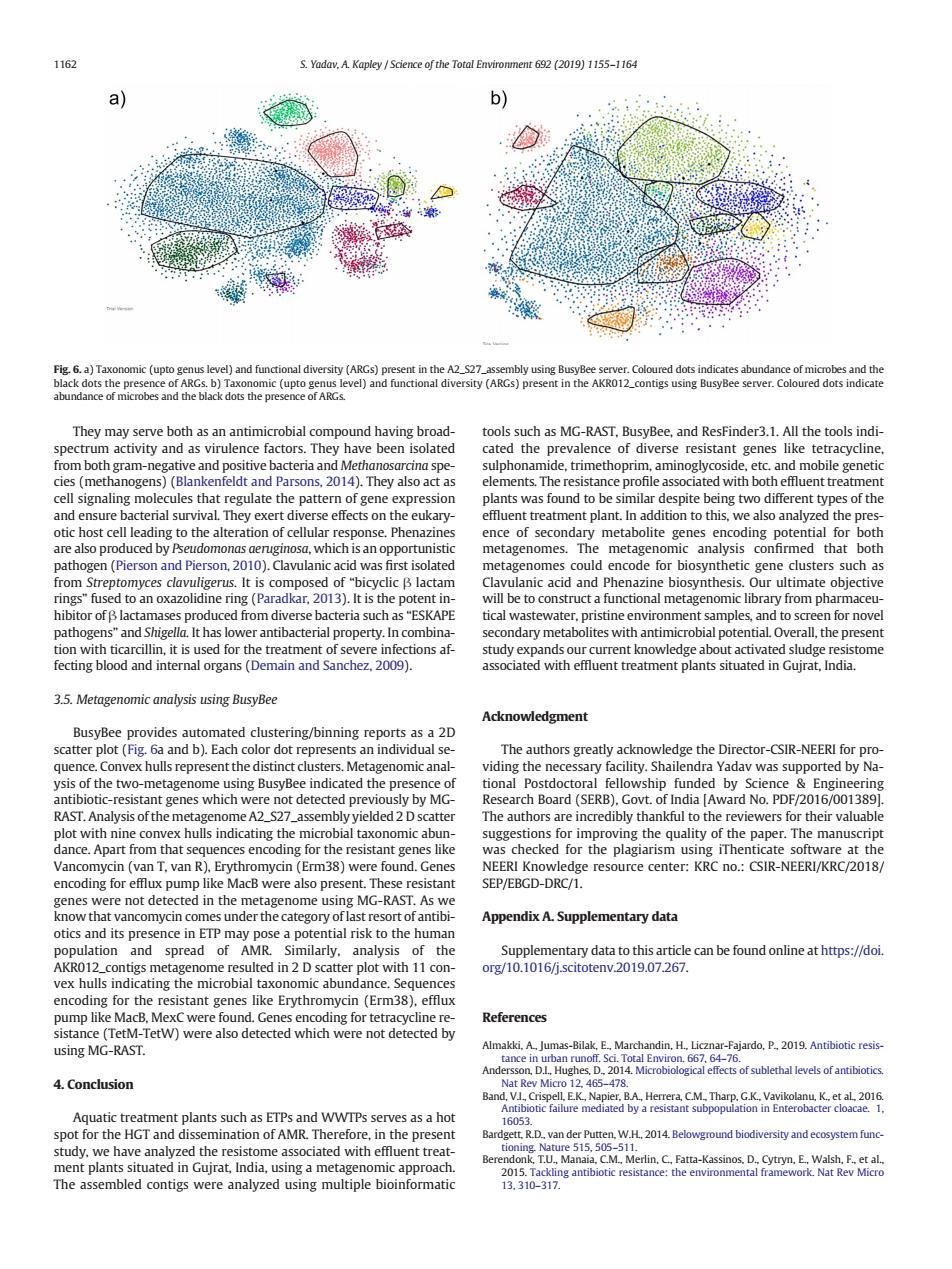正在加载图片...

a) om both gram e and po e bacteria and Methan s of the dition to this,w etabolit uced by genome anic acid an cteria such as "ESKAP samples, for nove edge about activa resistom cting bl with effluent treatment plants situa 35.Metagenomic analsis using BusyBee Acknowledgment ledee the Director-CSIR-NEERI represent thedistinct Metagenomican india Award No.PDF/2016/0013 stions for imp er Th cked to eCi-NEERUR MacB were also present G-RAST.AS ar SEP/EBGD-DRC/1. Appendix A.Supplementary data oulation and spread of AMR Similarly. analysis of the n38).efflu References Almakki,A.Jumas-Bilak.E.M 4.Conclusion tem func The assembled contigs were analyzed using multiple bioinformatic They may serve both as an antimicrobial compound having broadspectrum activity and as virulence factors. They have been isolated from both gram-negative and positive bacteria and Methanosarcina species (methanogens) (Blankenfeldt and Parsons, 2014). They also act as cell signaling molecules that regulate the pattern of gene expression and ensure bacterial survival. They exert diverse effects on the eukaryotic host cell leading to the alteration of cellular response. Phenazines are also produced by Pseudomonas aeruginosa, which is an opportunistic pathogen (Pierson and Pierson, 2010). Clavulanic acid was first isolated from Streptomyces clavuligerus. It is composed of “bicyclic β lactam rings” fused to an oxazolidine ring (Paradkar, 2013). It is the potent inhibitor of β lactamases produced from diverse bacteria such as “ESKAPE pathogens” and Shigella. It has lower antibacterial property. In combination with ticarcillin, it is used for the treatment of severe infections affecting blood and internal organs (Demain and Sanchez, 2009). 3.5. Metagenomic analysis using BusyBee BusyBee provides automated clustering/binning reports as a 2D scatter plot (Fig. 6a and b). Each color dot represents an individual sequence. Convex hulls represent the distinct clusters. Metagenomic analysis of the two-metagenome using BusyBee indicated the presence of antibiotic-resistant genes which were not detected previously by MGRAST. Analysis of the metagenome A2_S27_assembly yielded 2 D scatter plot with nine convex hulls indicating the microbial taxonomic abundance. Apart from that sequences encoding for the resistant genes like Vancomycin (van T, van R), Erythromycin (Erm38) were found. Genes encoding for efflux pump like MacB were also present. These resistant genes were not detected in the metagenome using MG-RAST. As we know that vancomycin comes under the category of last resort of antibiotics and its presence in ETP may pose a potential risk to the human population and spread of AMR. Similarly, analysis of the AKR012_contigs metagenome resulted in 2 D scatter plot with 11 convex hulls indicating the microbial taxonomic abundance. Sequences encoding for the resistant genes like Erythromycin (Erm38), efflux pump like MacB, MexC were found. Genes encoding for tetracycline resistance (TetM-TetW) were also detected which were not detected by using MG-RAST. 4. Conclusion Aquatic treatment plants such as ETPs and WWTPs serves as a hot spot for the HGT and dissemination of AMR. Therefore, in the present study, we have analyzed the resistome associated with effluent treatment plants situated in Gujrat, India, using a metagenomic approach. The assembled contigs were analyzed using multiple bioinformatic tools such as MG-RAST, BusyBee, and ResFinder3.1. All the tools indicated the prevalence of diverse resistant genes like tetracycline, sulphonamide, trimethoprim, aminoglycoside, etc. and mobile genetic elements. The resistance profile associated with both effluent treatment plants was found to be similar despite being two different types of the effluent treatment plant. In addition to this, we also analyzed the presence of secondary metabolite genes encoding potential for both metagenomes. The metagenomic analysis confirmed that both metagenomes could encode for biosynthetic gene clusters such as Clavulanic acid and Phenazine biosynthesis. Our ultimate objective will be to construct a functional metagenomic library from pharmaceutical wastewater, pristine environment samples, and to screen for novel secondary metabolites with antimicrobial potential. Overall, the present study expands our current knowledge about activated sludge resistome associated with effluent treatment plants situated in Gujrat, India. Acknowledgment The authors greatly acknowledge the Director-CSIR-NEERI for providing the necessary facility. Shailendra Yadav was supported by National Postdoctoral fellowship funded by Science & Engineering Research Board (SERB), Govt. of India [Award No. PDF/2016/001389]. The authors are incredibly thankful to the reviewers for their valuable suggestions for improving the quality of the paper. The manuscript was checked for the plagiarism using iThenticate software at the NEERI Knowledge resource center: KRC no.: CSIR-NEERI/KRC/2018/ SEP/EBGD-DRC/1. Appendix A. Supplementary data Supplementary data to this article can be found online at https://doi. org/10.1016/j.scitotenv.2019.07.267. References Almakki, A., Jumas-Bilak, E., Marchandin, H., Licznar-Fajardo, P., 2019. Antibiotic resistance in urban runoff. Sci. Total Environ. 667, 64–76. Andersson, D.I., Hughes, D., 2014. Microbiological effects of sublethal levels of antibiotics. Nat Rev Micro 12, 465–478. Band, V.I., Crispell, E.K., Napier, B.A., Herrera, C.M., Tharp, G.K., Vavikolanu, K., et al., 2016. Antibiotic failure mediated by a resistant subpopulation in Enterobacter cloacae. 1, 16053. Bardgett, R.D., van der Putten, W.H., 2014. Belowground biodiversity and ecosystem functioning. Nature 515, 505–511. Berendonk, T.U., Manaia, C.M., Merlin, C., Fatta-Kassinos, D., Cytryn, E., Walsh, F., et al., 2015. Tackling antibiotic resistance: the environmental framework. Nat Rev Micro 13, 310–317. Fig. 6. a) Taxonomic (upto genus level) and functional diversity (ARGs) present in the A2_S27_assembly using BusyBee server. Coloured dots indicates abundance of microbes and the black dots the presence of ARGs. b) Taxonomic (upto genus level) and functional diversity (ARGs) present in the AKR012_contigs using BusyBee server. Coloured dots indicate abundance of microbes and the black dots the presence of ARGs. 1162 S. Yadav, A. Kapley / Science of the Total Environment 692 (2019) 1155–1164